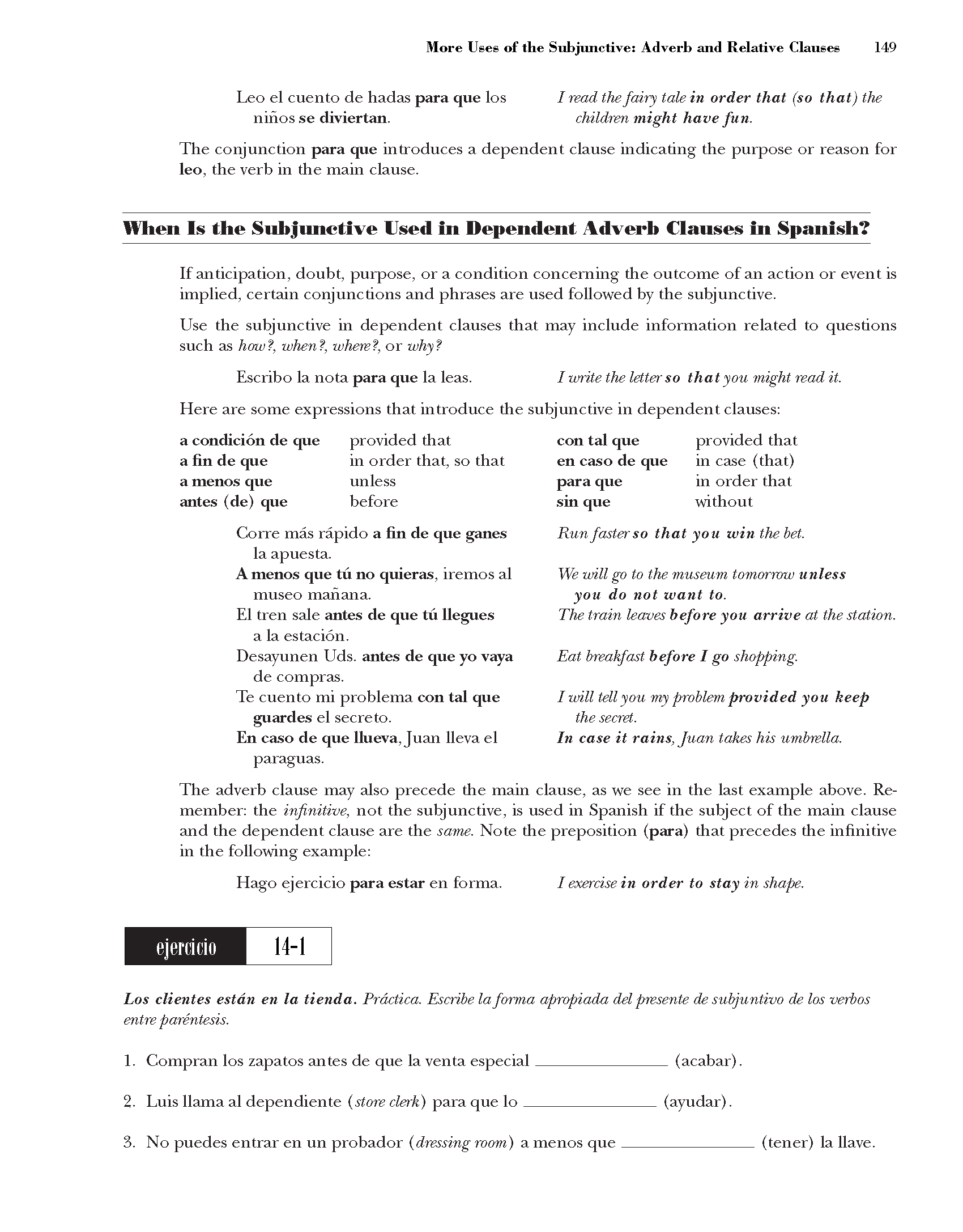CSG160

149
Morę Uses of the Subjunctive: Adverb and Relative Clauses
Leo el cuento de hadas para que los Iread the fairy talein order that (so that) the
nińos se diviertan. children might have fun.
The conjunction para que introduces a dependent clause indicating the purpose or reason for leo, the verb in the main clause.
Wlieii Is the Suhjunetive Used in Dependent Adverb Clauses in Spanish?
If anticipation, doubt, purpose, or a condition concerning the outcome of an action or event is implied, certain conjunctions and phrases are used followed by the subjunctive.
Use the subjunctive in dependent clauses that may include information related to questions
such as howf, whenf, wheref, or why?
Escribo la nota para que la leas.
Here are some expressions that introduce the
a condición de que provided that
a fin de que in order that, so that
a menos que unless
antes (de) que before
Corre mas rapido a fin de que ganes la apuesta.
A menos que tri no quieras, iremos al museo mańana.
El tren sale antes de que tu llegues
a la estación.
Desayunen Uds. antes de que yo vaya
de compras.
Te cuento mi problema eon tal que guardes el secreto.
En caso de que llueva, Juan lleva el paraguas.
I write the letterso thatyou might read it.
iubjunctive in dependent clauses:
eon tal que provided that
en caso de que in case (that) para que in order that
sin que without
Run faster so that you win the bet.
We will go to the museum tomorrow unless you do not want to.
The train leaves before you arrive at the station.
Eat breakfast before I go shopping.
I will tell you my problem prouided you keep the secret.
In case it rains, Juan takes his umbrella.
The adverb clause may also precede the main clause, as we see in the last example above. Re-member: the infinitive, not the subjunctive, is used in Spanish if the subject of the main clause and the dependent clause are the same. Notę the preposition (para) that precedes the infinitive in the following example:
Hago ejercicio para estar en forma. I exercisein order to stay in shape.
14-1
ejercicio
Los clientes estan en la tienda. Prdctica. Escribe la forma apropiada delpresente desubjuntwo de los verbos entre parentesis.
1. Compran los zapatos antes de que la venta especial_ (acabar).
2. Luis llama al dependiente (storę clerk) para que lo_ (ayudar).
3. No puedes entrar en un probador (dressing room) a menos que_ (tener) la llave.
Wyszukiwarka
Podobne podstrony:
CSG162 Morę Uses of the Subjunctive: Adverb and Relative Clauses 151 14-4ejercicio Pareados. Luisy A
CSG166 Morę Uses of the Subjunctive: Adverb and Relative Clauses 155 8. Guando... mi
CSG162 Morę Uses of the Subjunctive: Adverb and Relative Clauses 151 14-4ejercicio Pareados. Luisy A
CSG164 153 Morę Uses of the Subjunctive: Adverb and Relative Clauses 2. She brings
CSG166 Morę Uses of the Subjunctive: Adverb and Relative Clauses 155 8. Guando... mi
CSG168 157 Morę Uses of the Subjunctive: Adverb and Relative Clauses 4. People nee
CSG170 159 Morę Uses of the Subjunctive: Adverb and Relative Clauses Saludare a Manuel dondequiera q
CSG172 161 Morę Uses of the Subjunctive: Adverb and Relative Clauses 3. Probably B
CSG159 Unit 14Morę Uses of tlie Subjunctive: Adverb and Relative ClausesThe Suhjunetive in Adve
CSG178 167 The Subjunctive Mood Past Tenses: The Imperfect and the Pluperfect SubjunctiveOther Uses
00447 ?f1c5bb48f7e26d8f6ac58ed45c496d 452RussellEiample of Uses of the Univariate Phase Map Movie,
Below are morę photos of the FOL symbol found in India. Submitted by Aiyana Willard (Canada). e
więcej podobnych podstron